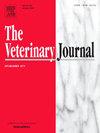利多卡因椎旁麻醉中加入托咪定对奶牛站立性皱胃移位术的内、术后影响
IF 3.1
2区 农林科学
Q1 VETERINARY SCIENCES
引用次数: 0
摘要
本研究探讨了在利多卡因近端椎旁神经阻滞(PPNB)中加入托咪定对牛站立剖腹手术的益处。选取40头接受手术治疗的成年奶牛,随机分为两组,一组接受含有利多卡因(利多卡因:40 ml 2 %利多卡因每个注射部位)或利多卡因-托托咪定(利多卡因-托托咪定:利多卡因+ 5 μg/kg托托咪定均匀分布于利多卡因注射器)的PPNB。在T13、L1和L2椎体进行PPNB,总是由同一位研究者使用盲法进行。术中镇静评分、疼痛评分、心脏(HR)、呼吸频率(RR)分别在PPNB术前和术后(5、10、15 min,然后每15 min)由盲法观察者(ODA)记录。根据盲法术者的决定,应用局部利多卡因镇痛。在干预结束时,外科医生还使用视觉模拟量表(VAS)评估麻醉质量。术后疼痛在0、2、6、12和24 小时采用z本文章由计算机程序翻译,如有差异,请以英文原文为准。
Intra and postoperative effects of adding detomidine to a lidocaine paravertebral anaesthesia in cows undergoing standing abomasum displacement surgery
This study investigated the benefits of adding detomidine to a lidocaine proximal paravertebral nerve block (PPNB) for standing laparotomy in cattle. Forty adult cows undergoing surgery for abomasal displacement were randomly assigned to receive a PPNB with lidocaine (LIDO: 40 ml 2 % lidocaine per injection site) or lidocaine-detomidine (LIDO-DETO: lidocaine + 5 μg/kg detomidine equally distributed to the lidocaine syringes). The PPNB was done at T13, L1 and L2 vertebra, always by the same investigator using a blind technique. Intraoperative sedation score, pain score, heart (HR) and respiratory rate (RR) were recorded before PPNB and repeatedly after (5, 10, 15 min, then every 15 min) by a blinded observer (ODA). Rescue analgesia (local lidocaine infiltration) was applied based on the blinded surgeon’s decision. Quality of anaesthesia was also assessed by the surgeons using a visual analogue scale (VAS) at the end of the intervention. Postoperative pain was evaluated (ODA) using the Zürich Composite Measure Pain Scale (ZCMPS) and mechanical nociceptive threshold (MNT) testing at 0, 2, 6, 12, and 24 hours. Surgery was completed in all cows, though two (LIDO-DETO) went into sternal recumbency. LIDO-DETO resulted in superior VAS (P < 0.001), higher sedation (P < 0.001), lower pain scores (P = 0.001), and reduced RR (P = 0.015). Postoperatively, LIDO-DETO cows showed significantly lower ZCMPS (P = 0.048) and higher MNT on the wound's left side (P = 0.026). Adding detomidine to lidocaine PPNB improved intraoperative anaesthesia quality with potential postoperative analgesic benefits.
求助全文
通过发布文献求助,成功后即可免费获取论文全文。
去求助
来源期刊

Veterinary journal
农林科学-兽医学
CiteScore
4.10
自引率
4.50%
发文量
79
审稿时长
40 days
期刊介绍:
The Veterinary Journal (established 1875) publishes worldwide contributions on all aspects of veterinary science and its related subjects. It provides regular book reviews and a short communications section. The journal regularly commissions topical reviews and commentaries on features of major importance. Research areas include infectious diseases, applied biochemistry, parasitology, endocrinology, microbiology, immunology, pathology, pharmacology, physiology, molecular biology, immunogenetics, surgery, ophthalmology, dermatology and oncology.
 求助内容:
求助内容: 应助结果提醒方式:
应助结果提醒方式:


